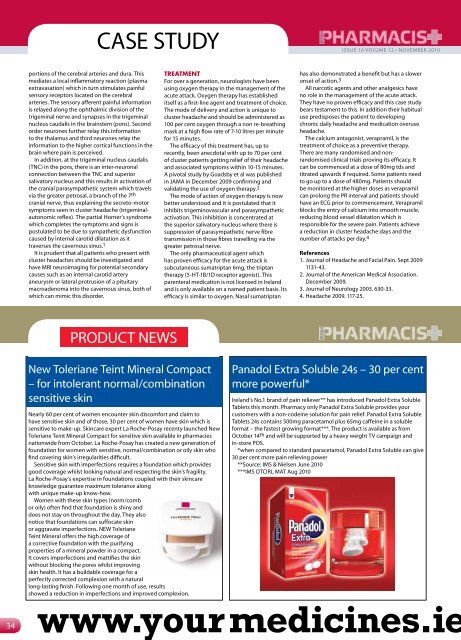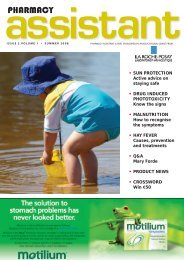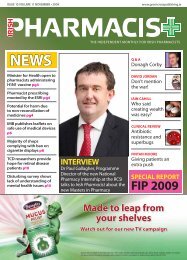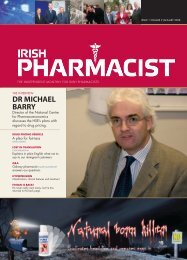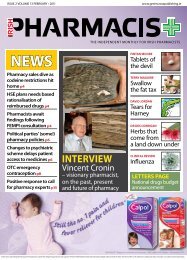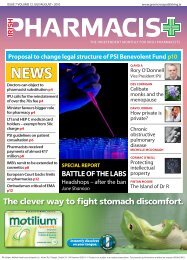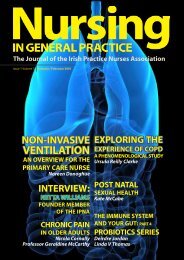inTervieW - Green Cross Publishing
inTervieW - Green Cross Publishing
inTervieW - Green Cross Publishing
You also want an ePaper? Increase the reach of your titles
YUMPU automatically turns print PDFs into web optimized ePapers that Google loves.
34<br />
portions of the cerebral arteries and dura. This<br />
mediates a local inflammatory reaction (plasma<br />
extravasation) which in turn stimulates painful<br />
sensory receptors located on the cerebral<br />
arteries. The sensory afferent painful information<br />
is relayed along the ophthalmic division of the<br />
trigeminal nerve and synapses in the trigeminal<br />
nucleus caudalis in the brainstem (pons). Second<br />
order neurones further relay this information<br />
to the thalamus and third neurones relay the<br />
information to the higher cortical functions in the<br />
brain where pain is perceived.<br />
In addition, at the trigeminal nucleus caudalis<br />
(TnC) in the pons, there is an inter-neuronal<br />
connection between the TnC and superior<br />
salivatory nucleus and this results in activation of<br />
the cranial parasympathetic system which travels<br />
via the greater petrosal, a branch of the 7th<br />
cranial nerve, thus explaining the secreto-motor<br />
symptoms seen in cluster headache (trigeminalautonomic<br />
reflex). The partial Horner’s syndrome<br />
which completes the symptoms and signs is<br />
postulated to be due to sympathetic dysfunction<br />
caused by internal carotid dilatation as it<br />
traverses the cavernous sinus.1<br />
It is prudent that all patients who present with<br />
cluster headaches should be investigated and<br />
have MRI neuroimaging for potential secondary<br />
causes such as an internal carotid artery<br />
aneurysm or lateral protrusion of a pituitary<br />
macroadenoma into the cavernous sinus, both of<br />
which can mimic this disorder.<br />
case sTudy<br />
pRoducT news<br />
new Toleriane Teint Mineral Compact<br />
– for intolerant normal/combination<br />
sensitive skin<br />
nearly 60 per cent of women encounter skin discomfort and claim to<br />
have sensitive skin and of those, 30 per cent of women have skin which is<br />
sensitive to make-up. Skincare expert la Roche-Posay recenty launched new<br />
Toleriane Teint Mineral Compact for sensitive skin available in pharmacies<br />
nationwide from October. la Roche-Posay has created a new generation of<br />
foundation for women with sensitive, normal/combination or oily skin who<br />
find covering skin’s irregularities difficult.<br />
Sensitive skin with imperfections requires a foundation which provides<br />
good coverage whilst looking natural and respecting the skin’s fragility.<br />
la Roche-Posay’s expertise in foundations coupled with their skincare<br />
knowledge guarantee maximum tolerance along<br />
with unique make-up know-how.<br />
Women with these skin types (norm/comb<br />
or oily) often find that foundation is shiny and<br />
does not stay on throughout the day. They also<br />
notice that foundations can suffocate skin<br />
or aggravate imperfections. nEW Toleriane<br />
Teint Mineral offers the high coverage of<br />
a corrective foundation with the purifying<br />
properties of a mineral powder in a compact.<br />
It covers imperfections and mattifies the skin<br />
without blocking the pores whilst improving<br />
skin health. It has a buildable coverage for a<br />
perfectly corrected complexion with a natural<br />
long-lasting finish. Following one month of use, results<br />
showed a reduction in imperfections and improved complexion.<br />
TreaTMenT<br />
For over a generation, neurologists have been<br />
using oxygen therapy in the management of the<br />
acute attack. Oxygen therapy has established<br />
itself as a first-line agent and treatment of choice.<br />
The mode of delivery and action is unique to<br />
cluster headache and should be administered as<br />
100 per cent oxygen through a non re-breathing<br />
mask at a high flow rate of 7-10 litres per minute<br />
for 15 minutes.<br />
The efficacy of this treatment has, up to<br />
recently, been anecdotal with up to 70 per cent<br />
of cluster patients getting relief of their headache<br />
and associated symptoms within 10-15 minutes.<br />
A pivotal study by Goadsby et al was published<br />
in JAMA in December 2009 confirming and<br />
validating the use of oxygen therapy.2<br />
The mode of action of oxygen therapy is now<br />
better understood and it is postulated that it<br />
inhibits trigeminovascular and parasympathetic<br />
activation. This inhibition is concentrated at<br />
the superior salivatory nucleus where there is<br />
suppression of parasympathetic nerve fibre<br />
transmission in those fibres travelling via the<br />
greater petrosal nerve.<br />
The only pharmaceutical agent which<br />
has proven efficacy for the acute attack is<br />
subcutaneous sumatriptan 6mg, the triptan<br />
therapy (5-HT-1B/1D receptor agonist). This<br />
parenteral medication is not licensed in Ireland<br />
and is only available on a named patient basis. Its<br />
efficacy is similar to oxygen. nasal sumatriptan<br />
issue 10 volume 12 • novemBeR 2010<br />
has also demonstrated a benefit but has a slower<br />
onset of action. 3<br />
All narcotic agents and other analgesics have<br />
no role in the management of the acute attack.<br />
They have no proven efficacy and this case study<br />
bears testament to this. In addition their habitual<br />
use predisposes the patient to developing<br />
chronic daily headache and medication overuse<br />
headache.<br />
The calcium antagonist, verapramil, is the<br />
treatment of choice as a preventive therapy.<br />
There are many randomised and nonrandomised<br />
clinical trials proving its efficacy. It<br />
can be commenced at a dose of 80mg tds and<br />
titrated upwards if required. Some patients need<br />
to go up to a dose of 480mg. Patients should<br />
be monitored at the higher doses as verapramil<br />
can prolong the PR interval and patients should<br />
have an ECG prior to commencement. Verapramil<br />
blocks the entry of calcium into smooth muscle,<br />
reducing blood vessel dilatation which is<br />
responsible for the severe pain. Patients achieve<br />
a reduction in cluster headache days and the<br />
number of attacks per day.4<br />
references<br />
1. Journal of Headache and Facial Pain. Sept 2009<br />
1131-43.<br />
2. Journal of the American Medical Association.<br />
December 2009.<br />
3. Journal of neurology 2003. 630-33.<br />
4. Headache 2009. 117-25.<br />
Panadol Extra Soluble 24s – 30 per cent<br />
more powerful*<br />
Ireland’s no.1 brand of pain reliever** has introduced Panadol Extra Soluble<br />
Tablets this month. Pharmacy only Panadol Extra Soluble provides your<br />
customers with a non-codeine solution for pain relief. Panadol Extra Soluble<br />
Tablets 24s contains 500mg paracetamol plus 65mg caffeine in a soluble<br />
format – the fastest growing format***. The product is available as from<br />
October 14 th and will be supported by a heavy weight TV campaign and<br />
in-store POS.<br />
*when compared to standard paracetamol, Panadol Extra Soluble can give<br />
30 per cent more pain relieving power<br />
**Source: IMS & nielsen June 2010<br />
***IMS OTCIRl MAT Aug 2010<br />
www.yourmedicines.ie


